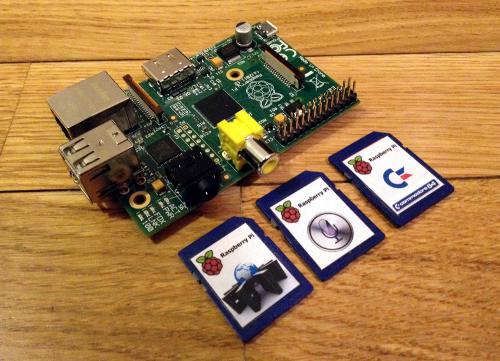Raspberry Pi
>>> Take a look at my new RPi blog! <<<

The Raspberry Pi (or RPi) is a credit-card sized computer that plugs into your TV and a keyboard.
It's a capable little PC which can be used for many of the things that your desktop PC does, like spreadsheets, word-processing and games.
It also plays high-definition video.
Its low price (about €20 model A e €27 model B) makes it an extremely useful and versatile "toy". These are the specifications:
- Broadcom processor BCM2835 700 MHz ARM1176JZFS with FPU and GPU Videocore 4
- GPU is OpenGL ES 2.0 compatibile, OpenVG with hardware accelleration and H.264/1080p30 decoding
- GPU performance: 1Gpixel/s, 1.5Gtexel/s o 24GFLOP with texture filtering and DMA
- 256MB RAM (model A), 512MB RAM (model B)
- Boot from SD using Linux
- USB 2.0 (1 plug x model A / 2 plugs x model B)
- 10/100 BaseT Ethernet (only model B)
- RCA and HDMI video out
- 3.5mm audio jack (also HDMI audio)
- Powered using microUSB (5V)
- Size 85.60 mm × 53.98 mm
- Header for direct accessing CPU digital signals (GPIO, SPI, I²C, UART)
Unfortunately it's not possible to install Windows on RPi. It's not due to the CPU power, but just because (at least for now) there's no Windows version compiled for
the RPi CPU.
This is not a big limitation, as Linux versions usable on RPi allow to do many of the things You can do with Microsoft systems.
It's true that configure a linux system it's not always an easy task, especially when dealing with a new hardware. This is why I decided to make available on my site
some SD images for specific Linux RPi configurations, so that people with low knwoledge of Linux could have an almost ready to use system.
All the SD images in this site share the follow specifications:
- S.O.Linux Debian Wheezy (Raspbian) updated to 14/02/2013
- Static IP address 192.168.0.30
- Standard user pi with password raspberry
- No graphic interface
- SSH protocol enabled
- Italian keyboard 105 keys
- Rome timezone
- Locale it
You can download the standard Raspbian SD image from the Raspberry Pi site.
Probably You could wish to change some of the parameters. In this case Just power on the RPi after connecting to TV and a a keyboard and type:
sudo raspi-config
to launch the configuration. Here You can change keyboard type, timezone, locale and SSH. You can also change CPU speed (yes, You can overclock the RPi!)
and choose tho enable the graphic interface.
To manage the configuartion just take a look at eLinux.org.
To change the IP address You have to use a text editor.
Power on the RPi and connect using default user (pi/raspberry). Then type the following commands:
cd /etc/networks
sudo nano interfaces
In the opened file You can find the following rows:
iface eth0 inet static
address 192.168.0.30
netmask 255.255.255.0
gateway 192.168.0.1
Just modify the parameters as needed and then save the file (using CTRL-O key combination and then RETURN) and exit (CTRL-X). Now You can restart RPi typing:
sudo reboot
If You do not need a static address, just delete the 3 rows starting with address, netmask e gateway and change the first row to
iface eth0 inet dhcp
These are the RPi sections:
F.A.Q.
Base
SiriProxy
C64 emulator
Web server
Installing Yowsup
Using Whatsapp



